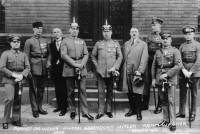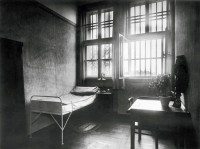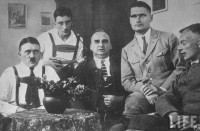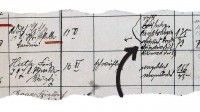The popular World War II song deriding the testicular constitution of top Nazi officials appears to have hit at least one nail on the head: Hitler really did only have one ball. The song, believed to have been written by a clever propagandist for the British Council in 1939, sung to the tune of the Colonel Bogey March originally put Goering in the first line with the one ball, but soon the two switched places in the verses and the song became a runaway success as a marching song for Allied troops and among school children on bus trips ever since.
 The new evidence comes from a recently surfaced medical certificate issued in 1924 by Dr. Josef Brinsteiner, the staff physician of Landsberg Prison in Bavaria where Hitler spent a few happy months after being convicted of treason. On the night of November 8th, 1923, Hitler, his Nazi Party cronies and 600 Sturmabteilung (SA) militia staged an armed takeover of a political rally in a Munich beer hall and attempted to overthrow the government of Bavaria with the overthrow of the Weimar government in Berlin as the ultimate target. Hitler was inspired by Mussolini’s 1922 March on Rome which had successfully installed Fascist rule in Italy, but the putsch was disorganized and came to a swift end when the Bavarian police fired on the marchers at the Munich Odeonsplatz on November 9th. Sixteen people, including four policemen, died.
The new evidence comes from a recently surfaced medical certificate issued in 1924 by Dr. Josef Brinsteiner, the staff physician of Landsberg Prison in Bavaria where Hitler spent a few happy months after being convicted of treason. On the night of November 8th, 1923, Hitler, his Nazi Party cronies and 600 Sturmabteilung (SA) militia staged an armed takeover of a political rally in a Munich beer hall and attempted to overthrow the government of Bavaria with the overthrow of the Weimar government in Berlin as the ultimate target. Hitler was inspired by Mussolini’s 1922 March on Rome which had successfully installed Fascist rule in Italy, but the putsch was disorganized and came to a swift end when the Bavarian police fired on the marchers at the Munich Odeonsplatz on November 9th. Sixteen people, including four policemen, died.
 Hitler was arrested on November 11th and tried three months later for high treason. He was convicted by sympathetic judges and sentenced to five years of the mildest type of imprisonment (no hard labour, long visiting hours, comfy cell) in Landsberg Prison, with the possibility of parole after six months. He was busted smuggling uncensored letters out of the prison, so his parole was slightly delayed. Hitler ended up serving 264 days of that sentence, a productive and apparently fun-filled nine months during which he dictated Mein Kampf to his fellow convict and future Deputy Führer Rudolf Hess.
Hitler was arrested on November 11th and tried three months later for high treason. He was convicted by sympathetic judges and sentenced to five years of the mildest type of imprisonment (no hard labour, long visiting hours, comfy cell) in Landsberg Prison, with the possibility of parole after six months. He was busted smuggling uncensored letters out of the prison, so his parole was slightly delayed. Hitler ended up serving 264 days of that sentence, a productive and apparently fun-filled nine months during which he dictated Mein Kampf to his fellow convict and future Deputy Führer Rudolf Hess.
The doctor’s report was part of a bundle of about 500 records from Landsberg Prison that were sold at auction on July 2nd, 2010, in Fürth, Bavaria. The seller’s father had acquired them in the 1970s at a flea market in Nuremberg. It seems they were stolen from Landsberg by the then-head of the prison in the 1960s. After his death, his estate was sold off at the flea market. There are no doubts as to documents’ authenticity.
 They describe an imprisonment virtually indistinguishable from a vacation at a nice B&B with bars on the windows. Every time Hitler had a visitor, the prison kept a record of the visit on a card. There are 330 cards, which means Hitler had quite the busy social schedule for the 264 days he spent at Landsberg. His close friend and supporter Ernst Hanfstaengl (who was half American, btw, and eventually turned coat and informed on his former bestie to Roosevelt) described his visits to Hitler in Landsberg as looking like he had “walked into a delicatessen. There was fruit and there were flowers, wine and other alcoholic beverages, ham, sausage, cake, boxes of chocolates and much more.”
They describe an imprisonment virtually indistinguishable from a vacation at a nice B&B with bars on the windows. Every time Hitler had a visitor, the prison kept a record of the visit on a card. There are 330 cards, which means Hitler had quite the busy social schedule for the 264 days he spent at Landsberg. His close friend and supporter Ernst Hanfstaengl (who was half American, btw, and eventually turned coat and informed on his former bestie to Roosevelt) described his visits to Hitler in Landsberg as looking like he had “walked into a delicatessen. There was fruit and there were flowers, wine and other alcoholic beverages, ham, sausage, cake, boxes of chocolates and much more.”
The estimate sale price for the Landsberg records was 25,000 euros ($27,000) but sale was blocked and the papers seized by the Bavarian government after they were quickly classified as nationally valuable archives. They’ve been in the State Archives in Munich ever since, and now Peter Fleischmann, the Head of the Nuremberg State Archives, has published an annotated edition of the papers after five years of study.
 Dr. Brinsteiner examined prisoner No. 45 (Hitler, Adolf) on November 12th, 1923, the day after his arrest. He noted in the “Record book for protective custody” that Hitler suffered from “right-sided cryptorchidism,” meaning his right testicle had never descended. Other than that, he was “healthy, strong” and weighed 78 kilograms. There’s no reason to think the good doctor was lying as he, like much of the rest of the prison staff, was a nationalist and Nazi sympathizer.
Dr. Brinsteiner examined prisoner No. 45 (Hitler, Adolf) on November 12th, 1923, the day after his arrest. He noted in the “Record book for protective custody” that Hitler suffered from “right-sided cryptorchidism,” meaning his right testicle had never descended. Other than that, he was “healthy, strong” and weighed 78 kilograms. There’s no reason to think the good doctor was lying as he, like much of the rest of the prison staff, was a nationalist and Nazi sympathizer.
Hitler’s testicles have been the subject of much speculation over the years. As early as 1943 Dr. Eduard Bloch, Hitler’s Jewish childhood physician who fled to America in 1940, was asked by the US military about the Führer nads. He assured them they were “completely normal.” In 1968, a Russian journalist published a book that included the report of an autopsy done on Hitler’s body by Soviet doctors in the bunker after the fall of Berlin. They claimed his left testicle had not only not descended, but was nowhere to be found up in there. That autopsy report had other errors, however, and the Soviets first insisted that Hitler had escaped with his life so the source is less than reliable.
In 2008, Polish priest and amateur historian Franciszek Pawlar claimed that he had heard from a German army medic that Hitler had lost a testicle from a shrapnel wound suffered at the Battle of the Somme. The Somme rumor had been floating around for years by then, one guy’s hearsay confirmation of it wasn’t exactly a slam dunk. The Landberg medical report, on the other hand, isn’t obscured by time, propaganda, mythology or gossip. It makes no comment on any resemblance to Himmler’s, the size of Goering’s and presence or absence of Goebbels’.